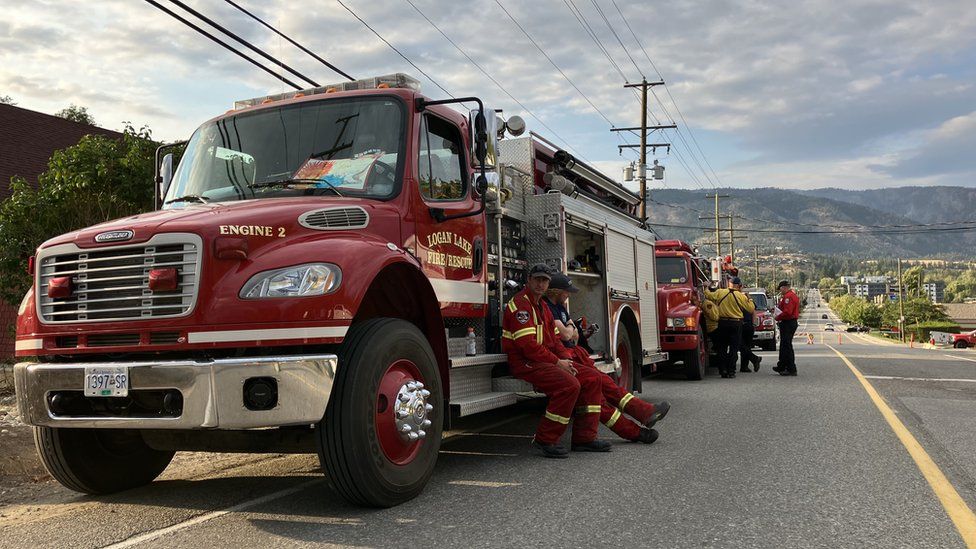Joanna Kelly is a barrister in the Kelowna law courts – this week she’s been given permission to appear in legal cases by video-link partly because she has very few formal clothes to wear. They, and most of her other possessions, went up in flames last week.
On her mobile phone, Joanna watches a grainy video of what used to be her house with Duncan Vickers – her friend and neighbour for decades. They’re now evacuees in Canada’s worst ever wildfire season.
Joanna says they had never seen anything like the inferno that tore through their Okanagan valley community, in the western province of British Columbia, destroying almost everything in its path, including their homes.
“It was blindingly bright and then it would get into a house,” says Joanna, as she describes watching the wall of fire from a vantage point on the other side of the lake. “There was a raging fire going through a skeleton-like building and it went from one to the next until there were dozens of destroyed structures.”
Her next-door neighbour Duncan, who emigrated to Canada in the 1970s, lost most of what he had built and owned – including his father’s World War Two medals. But, says Duncan, showing some of his native Yorkshire stoicism, his family is safe and everything else has to be put into perspective.
“I got my cars out, which is important,” he says. “It’s terrible, but you’ve got to be philosophical about these things.”
It’s still too dangerous and risky for Duncan, Joanna and other residents who lost their homes to return and pick up the pieces. But, from the vantage point of a boat on the lake, the devastation is clear to see.

What’s apparent is the indiscriminate nature of the wildfires. In parts of the waterfront communities, where houses back onto the forests, several homes have been completely destroyed by fire. House after house has been gutted. But then, all of a sudden, you come across buildings only yards away that have been barely touched by the blaze and are completely habitable.
Via security cameras, streamed to devices or phones in safe locations, some residents could watch and listen, helplessly in real time, as their houses burned. It’s a testament to local rescue services that no lives were lost. Jason Brolund is the local fire chief and was on the frontline with his crews in often perilous situations.
- The agonising wait to go home and survey wildfire damage
- The numbers behind Canada’s worst wildfires season
“There were times when our staff were surrounded on all sides by fire,” says the chief. “They would not say they were ‘trapped’ but there’s no question it’s been dangerous. We saw dramatic fire behaviour, with winds ripping up trees by their roots and laying them down like toothpicks.”
Most alarmingly, Chief Brolund wonders about how his relatively small department can cope with an ever-expanding fire season. Normally the team would be dealing with a relatively small number of blazes in July and August. Now, he says, they can be fighting wildfires from March to November.
He and many others with years of experience in this field are in no doubt that the increasing impact of human activity on the environment must bear much of the blame.

There have been more than 1,000 wildfires across Canada in the last week – a record number. As he toured a local evacuation centre I asked the province’s premier, David Eby, if he thought that climate change might be partly responsible for the spike in such incidents.
“Without a doubt,” said Mr Eby. “The ferocity of the fires and the extent of the burning, not just here in British Columbia, are clearly linked to human-caused climate change. We’re in the fourth year of drought here and that’s making the fires so much worse.”
The biggest fires may have been tamed, but there is still a significant threat as new seats of fire start up at various places in the tinder-dry forest. I watched as a small team of helicopters swooped over a local lake, scooping up water in huge buckets to try and douse a big fire on the other side of the valley that was clearly of concern to the authorities.
The helicopters flew and dropped water virtually from dawn till dusk and were back again the next day.
This crisis has undoubtedly strengthened the bond between the fire crews and a grateful public, who gather at fire houses in Kelowna to cheer home the firemen and firewomen after another exhausting day in the forest.
But most people here are under no illusion that the number and frequency of wildfires will become more common in the future.
This video can not be played
To play this video you need to enable JavaScript in your browser.
Related Topics
- Wildfires
- Climate change
- Environment
- British Columbia
- Canada
